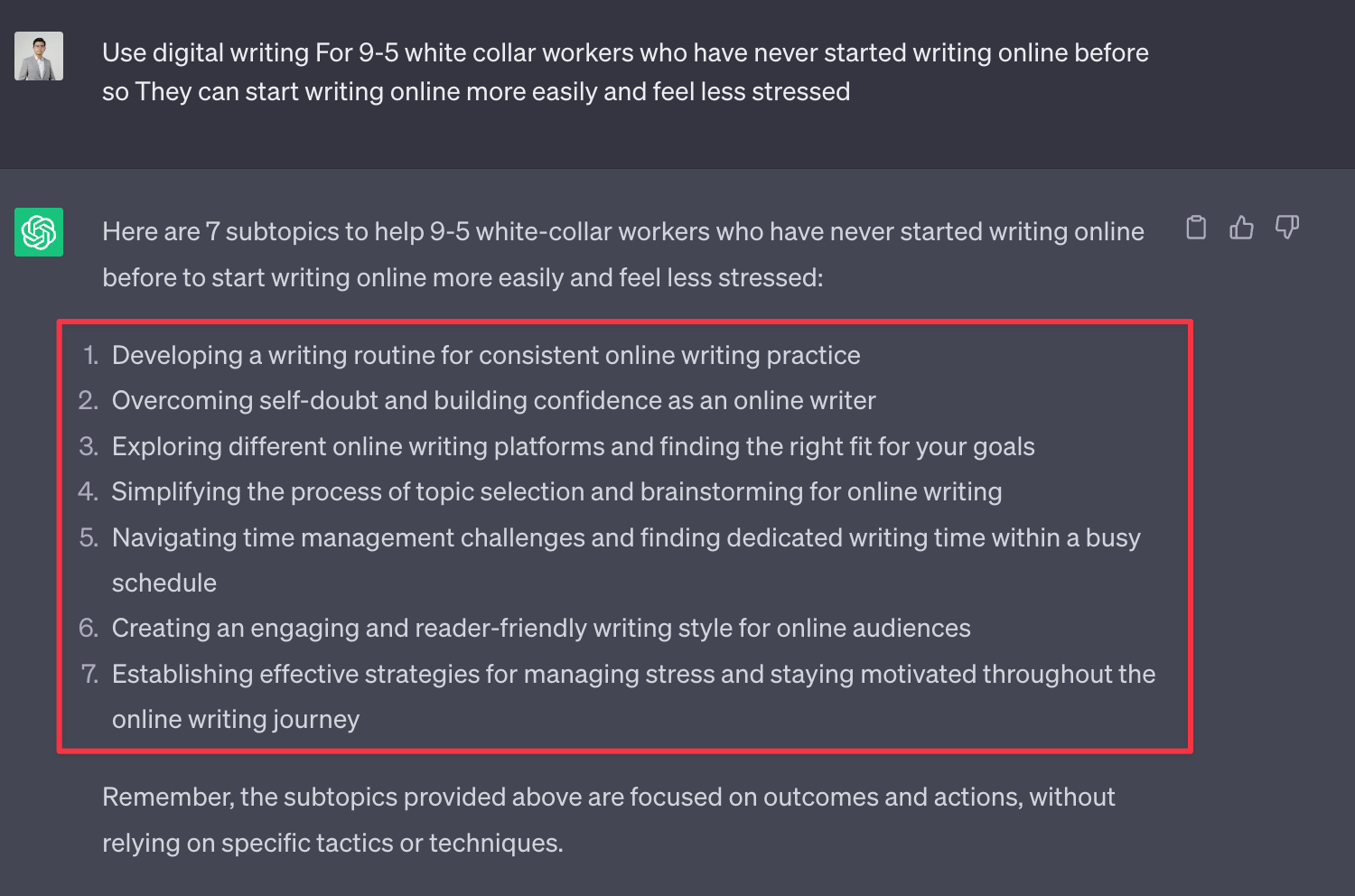超猛寫作流程!5 個步驟透過 Lean Writing 和 ChatGPT,幫助自己發想 4 個月的每日寫作題目 (上)
學會這個流程,你可以在短短 30 分鐘內,針對你的專業主題發想出 140 個寫作題目。

這篇文章要跟大家分享一個含金量超高的寫作流程-Lean Writing 搭配 ChatGPT。
學會這個流程,你可以在短短 30 分鐘內,針對你的專業主題發想出 140 個寫作題目。如果 1 天寫一個題目,140個題目足夠你寫 4.5 個月啦!
但在正式介紹這套流程前,我必須先幫各位複習 Lean Writing 這個寫作方法。
Lean writing 是一種快速產出、用數據驗證寫作題目的寫作方法,是由 Nicolas Cole 和 Dickie Bush 所發明。下面我整理出 Lean Writing 重要的 4 個步驟:
- 挖掘主題: 用 2 Year Test 挖掘出你想寫、能寫的寫作主題。例如「網路寫作」。(細節可以參考 經營個人品牌時,源源不絕寫出獨特內容的 1 個心法 - 2 year test)
- 設計鉤子: 針對你的主題,用 {寫給誰看} + {看完後有什麼好處} 的句型吸引讀者閱讀你的文章。例如「寫給想經營個人品牌的初學者,從0到1學習網路寫作」。(細節可以參考 寫作過程卡卡的嗎?分享 1 個模版、3 個步驟,幫助你將破碎靈感寫成邏輯清晰的文章)
- 大量寫文: 使用 AAAA 架構發想 30 個寫作題目,依序回答 30 個問題並寫成短文章。例如「3 個從 0 到 1 學習網路寫作的訣竅」。(細節可以參考 不知道要寫什麼?3 大步驟、4 大架構幫助你發想 30+ 的寫作題目)
- 驗證數據: 將短文章每天發表在社群媒體上(例如Facebook、Twitter),觀察每篇貼文的按讚數、分享數、留言數加總,並將總數高的貼文寫成長篇文章。(細節可以參考 寫作寫很久,但寫出來的內容都沒人看嗎?學習 Lean Writing 的數據驗證觀念, 4 個步驟讓你利用數據確認「你寫的主題是不是大家都想讀的」)
- 回到步驟 1
如果你觀察我的 Facebook、付費電子報,就可以看到這樣的脈絡。因為我在 Facebook 大量寫短文章,並將很多人按讚的貼文,再寫成長文章寄送付費訂閱的你。
你收到的每一篇文章,都是經過 Facebook 網友驗證、想要「看夠多」的完整版本(破 50-100 讚的貼文)。
在 Lean Writing 的寫作步驟中,最困難的是「步驟 3-大量寫文」。因為:
需要回答 30+ 個寫作題目,而有些題目是自己不擅長的 (例如我非常不會寫「個人故事」類型的文章)。
因此我很好奇:有沒有方法可以幫助我「發想寫作題目的答案 (步驟 3)」?
答案呢...就是下方要分享給你的內容!
這套流程來自於 Dickie Bush & Nicolas Cole 的新付費訂閱產品-Write with AI,原文出自於 1 Topic, 100 Ideas: How To Use ChatGPT To Create An Endless "Idea File"。
他們使用了 3 個 ChatGPT 的模版,用 AI 的力量幫助我們一起發想「寫作題目的答案 (Lean Writing 的步驟 3)」 。
但細節到底是怎麼做呢?
有 5 個步驟
- 自己定義出「寫作主題 (Topic)」
- 請 ChatGPT 發想「寫作子主題 (Subtopic)」
- 請 ChatGPT 發想「寫作子主題 (Subtopic)」的 20 個寫作問題
- 請 ChatGPT 發想 20 個寫作問題的答案
- 重複步驟 2 ~ 4
學會了這 5 個步驟,從此之後保證你不缺寫作題目!
準備好了嗎?讓我們一起來學習這套超猛的流程吧。
P.S. 這篇文章我們先講前面 2 個步驟,下篇文章再講後面 3 個步驟。
步驟 1. 定義出「寫作主題 (Topic)」
先定義我們的「寫作主題」。
參考 寫作過程卡卡的嗎?分享 1 個模版、3 個步驟,幫助你將破碎靈感寫成邏輯清晰的文章 的步驟 1 ,「寫作主題」可以這樣寫:
{What} + {For Who} + {So That}
– What: 我要寫「什麼」– Who: 要寫給「誰」看,他們遇到什麼「問題」– So that: 所以看完後「有什麼好處」
例如:
- What:用網路寫作
- Who:給朝九晚五、過去從來沒在網路上寫作的白領工作者
- So That:讓他們可以更輕鬆、更沒有壓力地開始在網路上寫作
請注意,因為 ChatGPT 的模版是英文、加上用英文跟 ChatGPT 對話效果會比較好,因此我們將上方的句子依序翻譯成英文。
- What:Use digital writing
- Who:For 9-5 white collar workers who have never started writing online before
- So That:They can start writing online more easily and feel less stressed
所以「寫作主題」就是:
Use digital writing For 9-5 white collar workers who have never started writing online before SO THAT They can start writing online more easily and feel less stressed
到這邊,我們就有了清楚的「寫作主題」。
下方我在多舉 2 個例子給你看:
- What:用卡片盒筆記法
- Who:給知識工作者
- So That:讓他們可以克服快速忘記資訊以及無法重複利用想法
所以「寫作主題」就是:
Use Zettelkasten For knowledge workers SO THAT They can overcome rapidly forgetting information and the inability to reuse it effectively (使用)
或是
- What:用子彈筆記法
- Who:給數位時代的人
- So That:讓他們可以克服生活在數位時代下的內心焦慮
所以「寫作主題」就是:
Use bullet journal For modern individuals in the digital age SO THAT They can overcome inner anxiety for modern individuals in the digital age
現在,換你用 {What} + {Who} + {So That} 寫下自己的「寫作主題」。
寫完後,就可以進入到下一步。
步驟 2. 請 ChatGPT 發想「子主題 (Subtopic)」
有了「寫作主題」後,下一步就是發想「寫作子主題」。
你可能好奇為什麼還要發想子主題呢?答案是:寫作主題的範圍太大了,我們必須聚焦一點才好寫。
例如以上方的寫作主題來說:「給朝九晚五、過去從來沒在網路上寫作的白領工作者,用網路寫作讓他們可以更輕鬆、更沒有壓力地開始在網路上寫作」,這個主題可以講的範圍太廣了。
因此我們可以拆解成下方的子主題,像是:
- 克服寫作瓶頸,並保持寫作動力
- 推薦給朝九晚五白領工作者的的數位工具
- 寫給朝九晚五白領工作者的基本網路寫作教學
- 建立一個穩定的寫作習慣,以平衡工作與下班後的網路寫作
- 通過網路寫作建立個人品牌和網路影響力
但是怎麼拆解成子主題呢?這時候 ChatGPT 就派上用場了。
請將下方的模版內容直接貼到 ChatGPT 上。
I am a digital writer and you are my personal idea generation consultant.
You are an expert in coming up with topics and subtopics that my audience will find useful.
I want your help creating subtopic ideas for some of the topics I am interested in writing about
What are subtopics?
Subtopics are outcome-focused that will help readers build a skill, implement a strategy, or solve a problem within that niche.
Rules when creating subtopics:
- You MUST begin each subtopic with a verb to create a clear action-oriented focus.
- You MUST avoid using specific tactics or techniques within the subtopic, as those will become "proven approaches:"
Here are 40 potential subtopic "verbs" you can use:
- Mastering
- Developing
- Improving
- Building
- Enhancing
- Overcoming
- Achieving
- Optimizing
- Expanding
- Creating
- Exploring
- Analyzing
- Understanding
- Simplifying
- Strengthening
- Navigating
- Innovating
- Experimenting
- Refining
- Adapting
- Evolving
- Resolving
- Uncovering
- Conquering
- Growing
- Maximizing
- Streamlining
- Designing
- Strategizing
- Reframing
- Reinventing
- Establishing
- Refocusing
- Customizing
- Reducing
- Eliminating
- Leveraging
- Focusing
- Differentiating
- Aligning
Here is an example:
Topic: Running your first marathon
Subtopics:
- Developing a training plan for first-time marathon runners
- Buliding endurance and stamina through effective training strategies
- Overcoming mental barriers and staying motivated throughout the training process
- Creating a fueling and hydration strategy for race day
- Finding the right running shoes and gear for maximum comfort and performance
- Preventing and managing injurles during marathon training
- Creating a support network and finding a running community to stay accountable and motivated
- Balancing marathon training with family and work obligations
- Setting realistic goals and measuring progress throughout the training process
- Preparing mentally and emotionally for the physical and mental challenges of running a marathon.
Here is what I want to avoid:
- Tips for developing a training plan for first-time marathon runners
- Habits for building endurance and stamina through effective training strategies
- Books for overcoming mental barriers and staying motivated throughout the training process
- Strategies for fueling and hydration on race day
- Benefits of finding the right funning shoes
The difference between my ideal list and the list of what I want to avoid:
- Things in my "here is what I want to avoid list" are "proven approaches" that are ways to help the reader with the subtopic. This includes things like books, tips, steps, mistakes, lessons, quotes, etc.
- I want to avoid ever providing "proven approaches" as my subtopics.
Now, here is the assignment:
- You are going to help me generate 7 subtopics.
- You will ask me for the topic I want to write about. When I answer, you will reply with 7 subtopics and only that list of 7 subtopics.
Do you understand?
If so, confirm and ask me for the topic
ChatGPT 會要你輸入想要發想的「寫作主題 (Topic)」,請把步驟 1 寫的英文 Topic 貼到 ChatGPT 吧。
也就是下面這句話:
Use digital writing For 9-5 white collar workers who have never started writing online before so They can start writing online more easily and feel less stressed

此時 ChatGPT 就會幫助我們發想 7 個子主題,例如下方:

如果你對其中的 1 項內容不滿意,可以請他換一個。例如我請它更換第 2 項子主題。

喜歡的話,就可以把這 7 個問題保存下來、留到步驟 3 使用囉。
P.S. 你可能會好奇:「難道一次只能發想 7 個嗎?可不可以一次請他發想 30 個?」。答案是可以,但發想的題目品質會變差,我想這跟 ChatGPT 的文字處理長度有關 (Token 數量限制),因此建議發想 7 個就足夠了。
練習步驟 1 跟 2,幫助自己找到 7 個寫作子主題吧!
快速複習這兩個步驟:
- 步驟 1. 自己定義出「寫作主題 (Topic)」:使用 {What} + {Who} + {So That} 發想。
- 步驟 2. 請 ChatGPT 發想「寫作子主題 (Subtopic)」:將寫作主題放到 ChatGPT 中,自動產出 7 個子主題。
在下篇文章中,我會教你第 3 步驟–請 ChatGPT 發想「寫作子主題」的 20 個寫作問題。這樣你就能有 7 x 20 = 140 個寫作題目了!
BUT,請你先確實完成步驟 1 跟 2 ,這樣下一篇文章的內容才可以接下去做唷!
![[復盤寫作系列 5] 多數人對於復盤會有的迷思,以及破除迷思後可以得到的好處](https://images.unsplash.com/photo-1577297627665-432deebed1a5?crop=entropy&cs=tinysrgb&fit=max&fm=jpg&ixid=M3wxMTc3M3wwfDF8c2VhcmNofDQ5fHx0aGlua3xlbnwwfHx8fDE3MTkyMTAzNzR8MA&ixlib=rb-4.0.3&q=80&w=720)


Comments ()